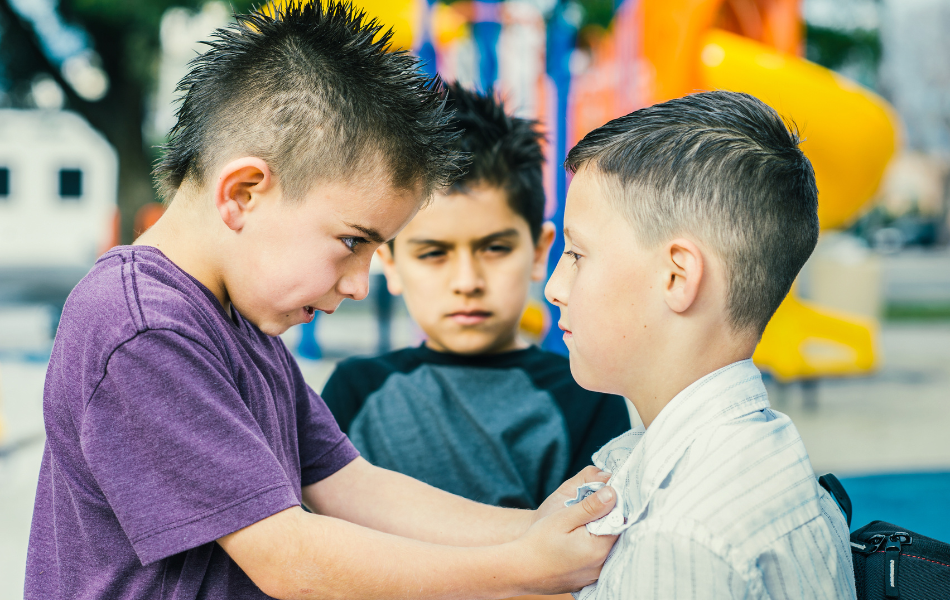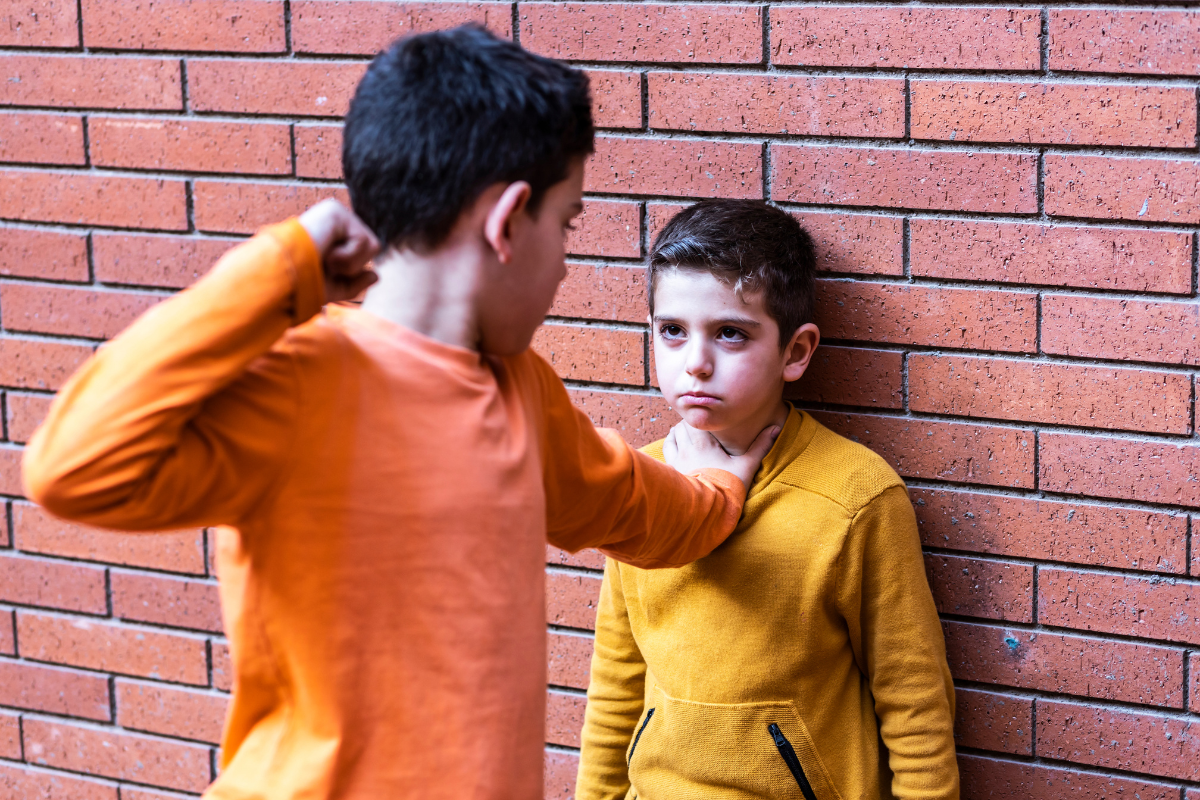Unlocking a Safer Environment for Kids: A Guide to Tackling Physical Bullying emphasizes the power of communication and signals in fostering resilience
Physical bullying involves the intentional use of force to harm another person, manifesting through actions like hitting, kicking, or other physical aggression. It’s a form of aggressive behavior aimed at asserting power and control over a victim.
Physical bullying is unfortunately prevalent in schools and communities, affecting countless children worldwide. The impact extends beyond visible injuries, often leading to emotional distress, anxiety, and a negative influence on academic performance.
Addressing physical bullying early is crucial to prevent long-term consequences. Swift intervention helps create a safer environment for children, promoting their mental and emotional well-being. Early actions also contribute to fostering a culture of respect and empathy, essential for healthy social development.
Recognizing Signs of Physical Bullying

Behavioral Changes in the Child
Watch for sudden shifts in behavior, such as increased irritability, withdrawal, or a noticeable decline in mood. Drastic changes in social interactions, sleep patterns, or academic performance can signal potential exposure to physical bullying.
Unexplained Injuries or Bruises
Pay close attention to any unexplained marks, bruises, or injuries on the child’s body. Inconsistent explanations or a reluctance to discuss the origin of these physical signs may indicate involvement in bullying situations.
Reluctance to Attend School or Participate in Activities
If a child shows reluctance to attend school or engage in previously enjoyed activities, it could be a red flag. This avoidance might stem from fear of encountering the bully or anxiety related to the bullying experience. Addressing this reluctance promptly is crucial to uncover potential issues and provide support.
A recommended book for parents is Bullying at School: What We Know and What We Can Do
Common Types of Physical Bullying
Hitting, Kicking, or Punching
One prevalent form of physical bullying involves direct physical aggression, such as hitting, kicking, or punching. This type of behavior is intended to cause harm and exert dominance over the victim.
Tripping or Pushing
Physical bullying can also manifest through actions like tripping or pushing. These seemingly minor acts can have significant consequences, leading to injuries and fostering an environment of fear and intimidation.
Stealing or Damaging Belongings
Another form of physical bullying extends to personal belongings. Bullies may engage in stealing or damaging possessions, violating a child’s sense of security and personal space. This type of aggression can have both material and emotional repercussions for the victim.
Real-life Examples of Physical Bullying
Scenario 1: Playground Altercation

In this scenario, a child is experiencing physical bullying during recess.
Problem: Child being pushed during recess
- The issue involves a child facing aggression through physical contact, specifically being pushed on the playground. This behavior poses a threat to the victim’s physical and emotional well-being.
Solution: Teaching assertiveness and conflict resolution skills
- To address this problem, it is essential to teach the child assertiveness and conflict resolution skills. Empowering the child to communicate boundaries effectively and resolve conflicts peacefully can help prevent further instances of physical bullying on the playground.
An example of what the child can say to address the situation assertively: “Hey, I don’t like being pushed. It’s not okay to treat me like that. Let’s talk and figure out a way to play together without anyone getting hurt. If something is bothering you, we can find a solution together. But pushing isn’t the right way to solve our problems.”
Scenario 2: Name-calling Escalating to Physical Harm

Problem: Verbal abuse turning into physical bullying
- The issue involves verbal abuse evolving into physical harm, creating an unsafe environment for the victim. This escalation from name-calling to physical aggression is a concerning pattern that needs prompt intervention.
Solution: Encouraging open communication and reporting incidents
- To address this problem, it is crucial to encourage open communication and prompt reporting of incidents. Victims should feel empowered to speak up about verbal abuse and seek assistance before it escalates. Creating a safe space for dialogue can help prevent the progression from name-calling to physical harm.
An example of what the child can say: “Stop calling me names. It’s not okay, and it hurts. Let’s talk about what’s bothering you instead of being mean. If you don’t stop, I’m going to tell a teacher or an adult because nobody should be treated this way.”
Scenario 3: Cyberbullying Leading to Physical Confrontations and Extreme Embarrassment

What is Cyberbullying
Cyberbullying is a form of harassment or intimidation that occurs through electronic means, typically on digital platforms such as social media, messaging apps, or online forums. Cyberbullying aims to cause harm, distress, or fear in the victim through various means, including spreading false information, sharing embarrassing content, or engaging in relentless online attacks.
Problem: Online harassment translating to depression and/or offline violence
Unlike traditional forms of bullying, cyberbullying leverages the anonymity and reach of the internet to target individuals, making it a pervasive issue. One of its defining characteristics is the rapid spread of harmful content. Given the interconnected nature of online spaces, hurtful messages or damaging material can quickly disseminate, reaching a wide audience within a short span. The swift and expansive nature of cyberbullying intensifies its impact, making timely intervention and reporting crucial to mitigate its adverse effects on the victim’s well-being.
Solution: Monitoring online activities and fostering resilience
To address this issue, it is crucial to monitor your child’s online activities closely. Fostering resilience is equally important. Educate your child on the importance of reporting cyberbullying incidents immediately, even if they feel embarrassed. Prompt reporting is essential as online conflicts can escalate rapidly. Make it clear that the priority is reporting rather than responding, emphasizing that you are there to support and intervene if needed.
How can a parent, or teacher intervene to stop cyberbullying
Intervening to stop cyberbullying requires a proactive and supportive approach from parents and teachers. Here are some effective strategies:
Open Communication:
- Foster open communication with your child or student. Create a safe space where they feel comfortable discussing their online experiences. Encourage them to share any instances of cyberbullying without fear of judgment.
Educate about Cyberbullying:
- Ensure that your child or students understand what cyberbullying is and its potential consequences. Educate them on responsible online behavior, emphasizing empathy, respect, and the impact of their words and actions.
Monitor Online Activities:
- Regularly monitor your child’s or student’s online activities without infringing on their privacy. Be aware of the platforms they use, the friends they connect with, and the content they share. This helps in the early detection of cyberbullying incidents.
Establish Rules and Boundaries:
- Set clear rules and boundaries regarding online behavior. Teach responsible digital citizenship and establish consequences for inappropriate actions. Consistent enforcement of these rules reinforces the importance of respectful online interactions.
Teach Reporting Mechanisms:
- Instruct your child or students on how to report cyberbullying incidents on various online platforms. Many platforms have reporting features that allow users to flag inappropriate content. Make sure they understand that reporting is a responsible and necessary action.
Involve School Authorities:
- If cyberbullying involves students from the same school, inform teachers, school counselors, or administrators. Collaborate with the school to address the issue collectively. Schools often have policies and procedures in place to handle such situations.
Empower Bystanders:
- Encourage bystanders to speak up against cyberbullying. Teach them the importance of supporting the victim and reporting incidents. A collective effort can create a stronger stance against online harassment.
Support the Victim:
- Provide emotional support to the victim. Let them know they are not alone, and that the bullying is not their fault. Offer guidance on coping strategies and involve mental health professionals if necessary.
Document the Evidence:
- If cyberbullying escalates, document the evidence. Take screenshots or save messages as proof. This documentation may be useful if legal action or further intervention becomes necessary.
Collaborate with Other Parents:
- If cyberbullying involves peers, communicate with the parents of the individuals involved. A collaborative effort between parents can address the issue comprehensively and promote a safer online environment for everyone.
By combining these strategies, parents and teachers can effectively intervene to stop cyberbullying and create a safer digital space for children and students.
Three online platforms that commonly have reporting features to address cyberbullying incidents: (your kids must be aware that this can be reported)
Facebook:
- Facebook provides users with the ability to report content, including posts, comments, and messages. Users can access the reporting option through the platform’s Help Center or by using the reporting tools available on individual posts or profiles.
Instagram:
- Instagram, owned by Facebook, offers reporting tools for users facing cyberbullying. Users can report inappropriate comments, photos, or profiles through the platform’s reporting feature, accessible from within the app.
Twitter:
- Twitter allows users to report incidents of harassment or abusive behavior. The reporting feature can be found on individual tweets, profiles, or through the platform’s Help Center. Users can specify the type of issue they are reporting, including harassment or cyberbullying.
It’s important to note that reporting mechanisms may vary across platforms, but major social media platforms generally provide tools to address and report instances of cyberbullying. Encouraging children, parents, and students to familiarize themselves with these reporting features empowers them to take action against online harassment.
Teaching Children to Tackle Physical Bullying
Encouraging Open Communication

To empower children to handle physical bullying, fostering open communication is paramount.
Creating a Safe Space for Children to Share Their Experiences
- Establish an environment where children feel safe expressing their feelings and experiences. This involves creating trust and assuring them that their concerns will be taken seriously.
Listening Actively and Without Judgment
Actively listen to children when they share their experiences, providing full attention without passing judgment. This involves validating their emotions and acknowledging the significance of their perspective. Active listening builds trust and encourages ongoing communication.
Building Self-Confidence

Promoting Self-Esteem Through Positive Reinforcement
- Boosting self-esteem is crucial in mitigating the impact of physical bullying. Provide positive reinforcement by acknowledging and praising a child’s strengths and achievements. This fosters a sense of self-worth and resilience.
Teaching Assertiveness Rather Than Aggression
- Empower children with assertiveness skills to express themselves confidently without resorting to aggression. Encourage them to communicate their needs and boundaries effectively, promoting a proactive and non-confrontational approach to resolving conflicts.
Instilling Empathy and Kindness
Helping Children Understand the Impact of Their Words and Actions
- Cultivating empathy begins with helping children recognize the real-world impact of their words and actions. Illustrate how their behavior can affect others emotionally and physically, fostering a deeper understanding of consequences.
Encouraging Empathy Towards Others
- Actively encourage children to consider and understand the feelings of their peers. By promoting empathy, children develop a sense of compassion and kindness, creating a more supportive and inclusive social environment.
Teaching Conflict Resolution Skills

Strategies for Peacefully Resolving Disputes
- Equip children with practical strategies to peacefully resolve disputes. Teach them the importance of effective communication, such as using “I” statements to express feelings and needs. Encourage active listening, allowing each party to understand the other’s perspective. Introduce compromise and negotiation as tools to find mutually agreeable solutions, fostering a collaborative approach to conflict resolution.
Seeking Help from Trusted Adults When Needed
- Emphasize that it’s okay to seek help when faced with challenging situations. Teach children to identify trusted adults, such as teachers, parents, or school counselors, who can provide guidance and support. This empowers children to recognize when a situation requires intervention beyond their capabilities, ensuring a timely and appropriate response to physical bullying incidents.
Communicating with the School and Authorities

Establishing a Partnership with Teachers and School Staff
To effectively address physical bullying, establish an open partnership with teachers and school staff. Regularly communicate with educators to stay informed about your child’s well-being and any potential concerns. This collaboration ensures a united front against bullying and facilitates a supportive environment for the child.
Reporting Incidents Promptly
Instruct your child to report any instances of physical bullying promptly. Timely reporting is crucial for swift intervention. Encourage a culture where reporting is seen as responsible and necessary, reinforcing that it contributes to creating a safer school environment for everyone.
| Here are some useful contacts that you and your child should be familiar with: National Bullying Helpline in the UK YoungMinds Kidscape Do some research if you are in other countries, normally under Bullying Helpline. Get the name, contact details and let your child know about these numbers. |
Understanding the School’s Anti-Bullying Policies
Familiarize yourself with the school’s anti-bullying policies. Understanding these policies equips you with the knowledge needed to navigate the school system effectively. Be aware of the procedures in place for addressing bullying incidents, ensuring a coordinated effort between parents, school staff, and authorities to address and prevent further occurrences.
Parental Involvement and Support

Regularly Checking in with the Child
Maintain open lines of communication by regularly checking in with your child. Create a comfortable space where they feel free to share their experiences and feelings. By staying engaged, you can better understand their social dynamics and promptly address any concerns related to physical bullying.
Providing Guidance Without Being Overly Controlling
Offer guidance to your child without becoming overly controlling. Provide advice on navigating social situations, handling conflicts, and building resilience. Balancing guidance with a level of independence allows the child to develop critical problem-solving skills while knowing they have a supportive foundation.
Seeking Professional Help if Needed
Recognize when professional assistance is necessary. If the effects of physical bullying persist or escalate, consider involving school counselors, psychologists, or other mental health professionals. Seeking external support ensures a comprehensive approach to addressing both the emotional and practical aspects of the child’s well-being.
Tom the Cat Stands Tall
A Tale of Tackling Physical Bullying
For younger children, they mustn’t feel alone. Reading stories about bullying helps them to relate to a character that also gets bullied.
One of the books I have written in my Emotional Explorers: Adventures in Understanding and Nurturing Feelings series, is Tom the Cat Stands Tall: A Tale of Tackling Physical Bullying

Conclusion

Addressing physical bullying in children requires a collaborative effort involving parents, educators, and professionals. By fostering open communication, teaching essential skills, and engaging with school authorities, a resilient foundation is built. With vigilant parental involvement, children can navigate challenges, ensuring a safe and supportive environment for their growth.
P.S. If your child is experiencing other emotions that you are finding hard to tackle please read my article on “Different Emotions”. Let’s help each other.
5 Introductory Questions to Ask your Child to Assess if they are being Bullied: respecting their privacy

- How has your day been lately?
- Open with a general question about their day, allowing them to share without feeling pressured. A sudden change in mood or reluctance to talk may signal underlying issues.
- Are there any challenges or concerns you’ve been facing at school or online?
- Encourage them to express any difficulties they may be experiencing, allowing them to share if they’re facing bullying without explicitly mentioning it.
- Who do you spend time with during breaks or after school?
- Ask about their social interactions casually, prompting them to share details about their friends or peers. Changes in friendships or avoidance of certain individuals may hint at bullying dynamics.
- Has anything happened recently that made you feel uncomfortable or upset?
- Frame the question broadly, inviting them to disclose any negative experiences without explicitly focusing on bullying. This approach respects their privacy while encouraging openness.
- How do you handle disagreements or conflicts with others?
- Inquire about their conflict resolution skills and experiences. This indirect approach may reveal if they’re dealing with bullying situations while allowing them to share at their comfort level.
Recent Posts
Discover how different parenting styles influence your child’s emotional growth and learn practical strategies to help them regulate emotions effectively. The way you parent today could shape...
Break the Cycle: Heal to Truly Support Your Children. Learn how childhood emotional neglect or abuse shapes parenting, and how to create lasting change. I’m writing this blog from personal...

